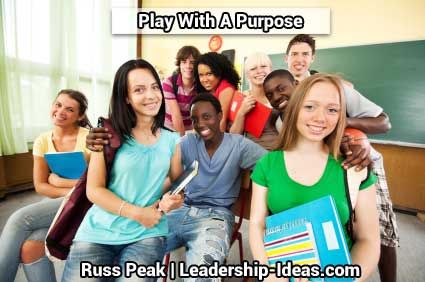How to Make Your Leadership Games Teach & Energize
A well-chosen selection of fun leadership games, team-building exercises, and icebreakers that get high school leaders up and moving is an invaluable part of any activity director’s arsenal. The right activity can break up the monotony of your class, work as a topic lead-in for your important leadership lessons, and create meaningful bonds among your student government. However, even the best group games depend on the skill of the game leader.
After 17 years, being involved with youth leadership conferences and classes, I’ve discovered what it takes to make a group game work and am excited to pass it on to you. Just use these simple secrets and you’ll be leading games like a pro!
Safety First!!
Keep your games safe! Just since it sounded fun on the internet, doesn’t mean that it’s the right game for your group. Use your common sense and be safety minded. NEVER introduce an icebreaker game that will make others uncomfortable – physically or mentally.
Play With A Purpose
Get to know me games are a great way to ease students through the discomfort that comes with getting to know strangers. However, don’t miss the opportunity to include valuable lessons into your fun. Pick games that purposefully demonstrate communication skills, team-building, empathy, and other student leadership qualities instead of letting those teachable moments pass you by.
Make Your Explanations Clear
Keep your games simple! Every rule you add is just one more obstacle between you and the success of your games. When giving the instructions, don’t assume they understand you. If possible, write them down for clarity, give an example, or bring a couple of students up to do a demonstration.
 Keep Things Moving
Keep Things Moving
Don’t spend too much time on any one game. Icebreakers that take longer than 15-minutes quickly lose their momentum! Advancing through two or three shorter high-action games related to your teaching topic is best. Pay attention to the participants to make sure that they’re having fun. If your game just isn’t working – move on to another.
Involve Everyone
Don’t force people to participate. However, both students and adults should be encouraged to join in the activities, or at least show respect by paying attention. Advisors and student helpers socializing or texting during your session will quickly kill the team-building energy you’re trying to create. Casually enlist your inattentive lurkers to partner up in for next game expressing that you could really use their help.
Follow Up With Discussion
At the end of your games, gather your student leaders for a discussion on the leadership skills that were just demonstrated through their play. Don’t expect your students to get ‘the lesson’ just by playing the game without an explanation as to how it relates to your topic. Have questions ready to act as a guide, but let your student leaders take the lead and talk about their “Aha!” moments.
• • • •
That’s it! Over the next several days I will be adding an online collection of my favorite quick yet effective leadership games complete with directions and follow-up discussion questions. Look for them under the blog category Play With Purpose. Let me know if you like ’em and I’ll keep adding. If you have any favorite energizer that you think readers would enjoy, additional discussion questions, or requests, please send them along to me.
Oh one last tip: Remember, they’re just games… so have fun!
Latest posts by Russ Peak (see all)
- A Simple Phrase That Leaders Need To Know - April 18, 2019
- Leaders Are Listeners: 10 Easy Steps to Effective Listening Skills - April 8, 2019
- How To Set Goals | Quality #4: Make Your Goals Personal - April 1, 2019
- How To Set Goals | Quality #3: Make Your Goals Reachable | - April 1, 2019
- How To Set Goals | Quality #2: Make Your Goals Specific - April 1, 2019


